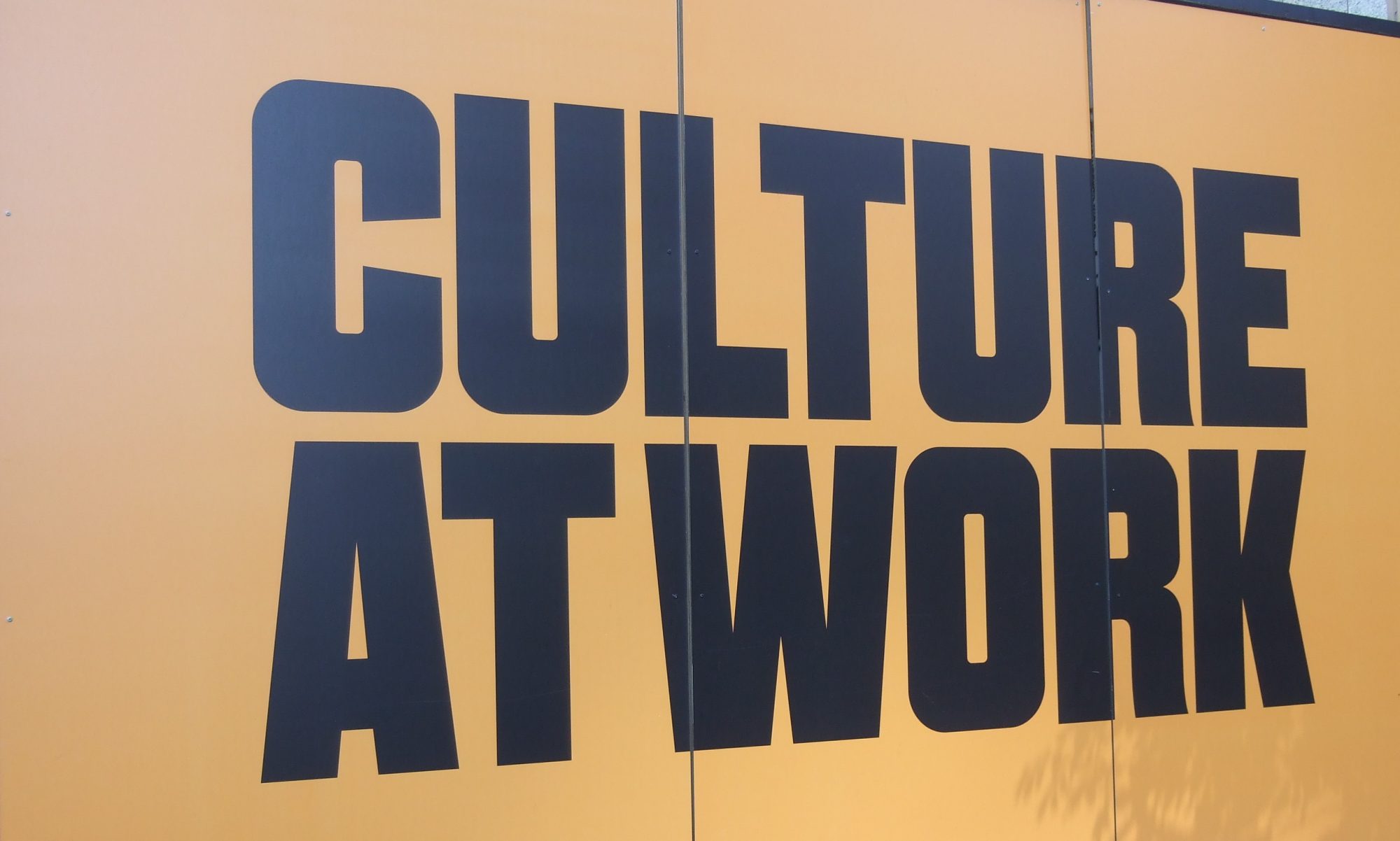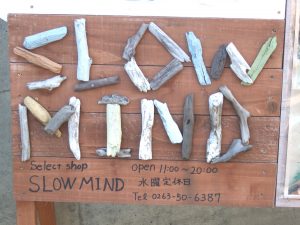
November 2016
Avalon Beach confirmed as a creative hub
It’s taken 12 months but as reported in my earlier Blog, the Avalon Beach Cultural Mapping Project is well and truly underway. It’s the beginning and not the end, with the data having been collected and the Report launched and published. The Map inventory confirms that Avalon Beach with its population of 10,000 is a hot bed of creativity on the Northern Beaches of Sydney. The seaside suburb is the home of a significant number of creative practitioners – artists and entrepreneurs – many of whom operate as sole traders or small creative enterprises.
The Avalon Beach Cultural Resources Mapping Project represents cutting edge urban and cultural planning. It was commissioned by the Avalon Preservation Association to complement its Visioning statement and was carried out on behalf of the community by a team of Avalon professionals with a commitment to providing evidence of the scope of Avalon Beach’s cultural resources which can feed into planning for Avalon’s future cultural vitality and urban development.
The Project has identified over 600 items for the Avalon Beach cultural resources or assets inventory ranging from heritage items, to spaces and facilities, events, community organisations, cultural businesses, parks and reserves as well as local customs, stories and traditions.
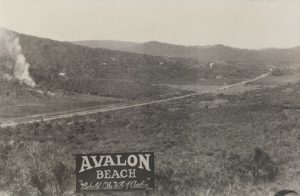
Behold the Vale of Avalon ca 1920s. Courtesy Avalon Beach Historical Society. |
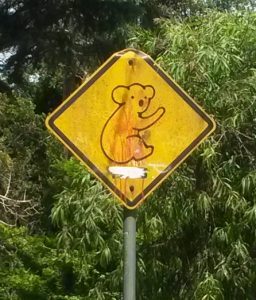
Koala road sign, Avalon Parade 2016 |
In consultation with the Avalon Beach community the Project also identified gaps or possibilities for the future including the urgent need for Welcome to Guringai signage, pop up artist spaces, cultural festivals and site-specific public art. It is hoped that the information will be fed into the Council’s forthcoming Avalon Beach Masterplan.
As well as being a grassroots driven cultural and urban planning initiative, the Mapping Project was keen to include the voices of young people in the cultural scan. A Crowd funding campaign (thanks to Chuffed) raised enough funds to appoint local photographer Sally Mayman as artist-mentor to Year 9 Barrenjoey High School visual arts students who worked together through Terms 3 and 4 to create artworks which capture the essence of Avalon Beach. These amazing youth art works were showcased during Avalon Market Day in November 2016.

Avalon Beach ocean pool, Charlotte, Year 9 |

Surfer and Avalon Headland, Zoe Kemp, Year 9 |
This is only the beginning of our unique project and the map is more than a list. The Project has cast a lens on one suburb, engaged with the community across generations and collected systematic data on the tangible and intangible assets that influence Avalon Beach’s identity, vitality, sense of place and quality of life. The Project aims to build evidence of Avalon’s cultural infrastructure – its strengths as well as its weaknesses – to inform planning and to develop a shared base of local knowledge. Over time we are hoping that this Project will open up opportunities for local creatives to participate and to be more visible and valued as a key aspect of Avalon’s distinct cultural lifestyle and as well as its economic wellbeing.
The Project has been supported by local community organisations including the Avalon Preservation Association, Eramboo Artist Environment, Palm Beach & Whale Beach Association, Barrenjoey High School and Northern Beaches Council. The Project Report can be downloaded here.
29 July 2016
Mapping our neighbourhood
Sometimes the stars align and opportunities arise to try something new in cultural planning. Over the years I’ve worked on my fair share of mapping projects where the focus has been on collecting broad cultural resource data (quantitative and qualitative) relating to a local government area. Generally the data collected results in a data base or inventory which provides a picture or map of the area’s cultural assets. At the same time and through consultations and via data-trawling we also develop a general idea of what may be missing and this informs the development of cultural plans and strategies for that place.
Right now I’m working on a cultural mapping project for a local neighbourhood or village within a much bigger local government area. The project is a grass roots initiative being driven by a team of residents with very specific skills, qualifications and experience and with a commitment to building evidence-based data that will inform decision making. Over 18 months and in anticipation of the local council’s intention to launch a Masterplanning project for the village, this Project has engaged with the local community to collect qualitative and quantitative information which documents the scope of local cultural resources. With urban design, placemaking, arts entrepreneurial, youth arts, public art and cultural planning skills our team brings a range of unique expertise to the project.
The Project has been hosted by the local progress association who have backed it from the start recognising that the Council’s Masterplan will be a critical opportunity to influence future development. The local council has provided in-principle support including ongoing encouragement and assistance with workshop venue hire and promotion. The Council recognises the value of the project as a complement to its documented arts strategies and programs. It also sees the project as a model for roll-out to other towns and villages.
The community has engaged with the data collection phase via postcard surveys of favourite assets, through workshops and via a youth mapping project at the local high school. They have worked together to confirm just what makes up this place’s arts and cultural assets and have signed off on the categories for systematic data collection. This is a very creative place so the arts and creativity are key aspects of its culture but so are the natural environment and sports.
So… where are we now. With a November 2016 deadline to launch the Cultural Mapping Project Report, we are building the database from information collected from the community. We have identified the village’s 5 favourite cultural assets through the postcard survey and have also identified what assets may be missing. Naturally we have also collected lots of amazing ideas for the future. Local high school students are working on capturing their ideas about local cultural resources via creative expression artworks to showcase at the Project launch.
As a community initiated project the process has been interesting to say the least but also professionally invigorating. The chance to try something new, to harness community ideas, to consider and refine processes, to listen to diverse voices and to maintain momentum with limited resources has been challenging. However knowing that this cultural planning project has a chance to make a difference to local sustainability and viability into the long-term is a tremendous lever. We are on the road to demonstrating the power of culture and the creative sector in influencing the daily lives of our community. And we are happy to share information on our mapping project via email.
May 2015
Cultural facility planning
One of the joys of working as a cultural planner is hearing from the community about their ideas and dreams for their local cultural futures. I work with a lot of Australian communities and usually with the local council as my client. The projects I have been involved with are many and diverse although lately I have been doing a lot of arts and cultural facility planning and review projects. This means thinking about established as well as proposed art galleries, museums, public libraries, theatres, arts centres and so on. Sometimes I’m engaged to carry out a management review of an existing facility and service and just recently I’ve been called on to prepare feasibility analyses on the concept for new facilities.
These planning studies are often long-term projects usually taking up to 10 years to realise from concept to opening day celebration. They are complex and require creative and imaginative thinking as well as active fundraising by community leaders working as persuasive advocates.
Examples of projects I’ve worked on that have resulted in a new facility and service include the award winning Blue Mountains Cultural Centre, the Wallsend District Library, Western Plains Cultural Centre, Dubbo, the Albury LibraryMuseum, the Glasshouse Port Macquarie, Coolamon Up to Date Store, and the forthcoming (opening September 2015) Albury Regional Art Gallery.
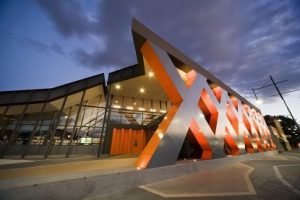
Albury LibraryMuseum exterior |
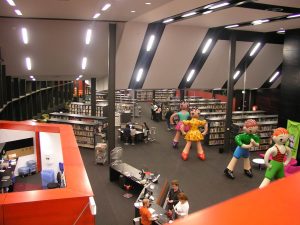
Albury LibraryMuseum interior |
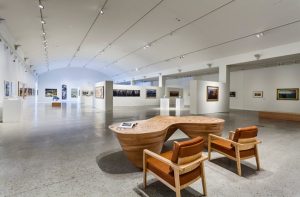
Blue Mountains Cultural Centre Katoomba |
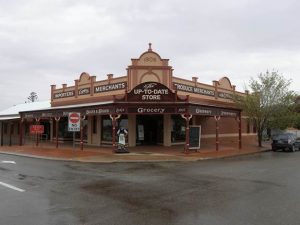
Up to Date Store, Coolamon |
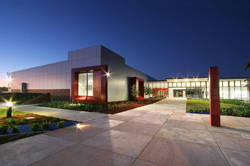
Western Plains Cultural Centre, Dubbo |
When I’m working with the local community one of the aspects of art gallery planning in particular that I’m keen to explore is ‘what makes a memorable art gallery experience?’ or what aspects of a gallery (or any cultural centre for that matter) will persuade you to make repeat visits over say a year? Interestingly I’m working again in an Australian regional city where I’ve now asked that question twice – once in 2009 and now again in 2015. The feedback which I’ve listed below is interesting for what is not listed as much as for what is listed and what are the elements noticed and valued by the community.
2009 Essential elements for a memorable experience:
- Diverse and flexible spaces that use space in an imaginative way
- Light and lighting including the use of natural light
- The arrival experience/ capacity to build anticipation in the design of the approach
- The external landscape including sculpture and gardens
- Child-friendly environment and children’s programs
- Diverse programs on offer including music events
- Showcasing the permanent collection plus temporary exhibitions
- Supporting local artists via a community gallery space
2015 essential elements
Note: The elements below are in addition to the above.
- Layers of interpretation – audio guides, podcasts, blogs, apps, new media etc.
- Focus on storytelling and rich program content
- Demonstrated connections to the local creative industries – i.e. use of local artists, designers, musicians, fashion etc.
- Delivering diversity of access for all audiences – e.g. ages and interests, cultural backgrounds
- Spaces and programs that build social inclusion and community cohesion
- Clever use of facility space including virtual space
- Research based – scholarship which enhances program content
- Creative arts workshops that encourage community participation and creativity
- Artists in residence – studios for artists programs and spaces
- Retail offer including shop, merchandise and e-shopping
- A human face – opening up the mystery; interpreting; outreach; proactive welcome and orientation; seating
These elements demonstrate some of the core planning aspects for art galleries in particular and reflect that the community understands the role of the physical building and its design but they also have strong views about what happens in that physical space. I’m fascinated by the gaps in the lists which may represent the particular circumstances of this regional city or may represent the community just honing in on their clear ideas of a gallery’s purpose or mission.
One of the distinctive features of the community feedback sessions that I design and manage is the generally universal sophistication of the Australian community in thinking about culture and arts related matters. For at least a decade I’ve noticed in workshops across the country that Australians are generally well-travelled and they have first-hand experiences of other places and other cultural buildings across Australia and overseas. They are keenly interested in ensuring that good ideas they observe in other places are considered when local possibilities are being planned. For example from Coolamon to Katoomba, Australia’s café driven culture has generally resulted in coffee shops being a core aspect of cultural facility planning. Most communities are keenly aware of the role of cafes in contributing to community cohesion whilst making an impact on local economic development.
I have a particular interest in building long term facility sustainability into the projects I work on and the identification of income streams that offset recurrent operational costs are often on my mind during the planning stage. This may not always be a concern to the local community although it certainly focuses the mind of the local council which is responsible for recurrent facility management. So … thinking about the gaps, here is my list of not to be overlooked essential cultural facility planning elements (in addition to the above):
- Space for co-located services or programs (e.g. public libraries/ galleries/ museums/ community radio/ historical society, start-ups, pop-ups etc.)
- Black box flexible, acoustic space for performance – music, theatre, dance, rehearsal etc.
- Café as a meeting place as well as an income stream
- External space for open-air markets (food/ artisan)
- Excellence in design – not necessarily ‘iconic’ but distinctive whilst demonstrating ESD principles, functional and memorable.
Planning and developing new or upgraded arts or cultural facilities provides opportunities to rethink delivery models, to think beyond the four walls and to set goals that have the potential to transform a place. Creative and imaginative facility design, development and management works best when the community has a respected voice in sharing ideas about the proposed facility and when participation is encouraged as an on-going an on-going and not a temporary or one-off phenomenon.
September 2014
Statistics damned statistics: making the case for Australian cultural statistics
The long term investment in the collection and analysis of Australian cultural statistics is something to be proud of. Australia is recognised as a leader in this field by countries such as Canada, United Kingdom, Finland and Spain. Support for this activity has come from all Australian States and Territories as well as from the Federal Government and this demonstrates the acknowledged benefit that access to robust and reliable data provides to decision makers, to policy and planners, and for impact analysis and evaluation.
In recent times the collection of relevant statistics, whilst always complex, has taken on added dimensions, due to the emergence of creative industry activity as a specific area of economic interest alongside broadly understood cultural activity.
Therefore, and due to the complexity of the cultural statistics sector, I value the expertise and experience of the management and staff at the National Centre for Culture and Recreation Statistics in Adelaide. As a cultural planner and strategist with clients in government, business and the community sectors, I regularly use the cultural statistical collections. In some cases I pay for specialist services from the Adelaide Centre, including the packaging of specific data for clients. I appreciate access to free data but also expect to pay for value-added services from experts in their field.
Now, as part of Federal budget reductions, the National Centre is being disbanded. This will result in a significant loss of reliable and objective information which in turn will impact on decision making, on accountability, on policy development and on Australia’s capacity to plan for and develop its cultural and recreation sectors for the future. It will also result in the loss of unique expertise, experience and qualifications in the specialised and complex area of culture and recreation data collection.
Clients for cultural statistics are diverse – they embrace interests in the government sectors as well as in the business and community sectors. This reflects the importance of culture to our ways of living, to our past, to our future and to better understanding diverse contemporary experiences of culture. In order to ensure quality decision making and value for money in cultural investments, Australia needs ongoing access to a rich and reliable database of comprehensive cultural statistics.
The decision to cease collecting arts and cultural data and to disband the Centre in Adelaide seems very short-sighted. Australia’s cultural sector is a vital building block for the future, and ongoing access to reliable and accurate data is an essential tool for decision makers, including for politicians. I have written to all the key Federal MPs in relation to this matter and I suggest you do the same. Key politicians include:
1. Minister for the Arts Senator.brandis@aph.gov.au
2. Acting Australian Statistician jonathan.palmer@abs.gov.au
3. Treasurer j.hockey@aph.gov.au
February 2014
Modernizing libraries – stewardship vs radical makeover
Some would say that the only constant in life is change. In the world of cultural development this is taken for granted. One of the essential features of culture is its capacity to change, to grow, to adapt and reflect, through habits, traditions and customs, contemporary lifestyles and ways of living.
Our cultural institutions in Australia have become adept at anticipating and managing change. They have had to do this to survive in a competitive marketplace where their users have high expectations of service quality and program excellence and where performance is scrutinised and funding is often uncertain. One of my particular areas of interest is the public library sector which to my mind has very successfully demonstrated its capacity to change and to thrive in the face of significant change and challenge.
My understanding of public libraries – their historical foundations, their sense of place in the community and their broad cultural, social and economic responsibilities is based on decades of association. I’ve been a library user since primary school and have worked in and ultimately managed complex public library services in metropolitan Sydney. I have also undertaken a number of management reviews of urban and regional public library services across New South Wales, Queensland and the ACT.
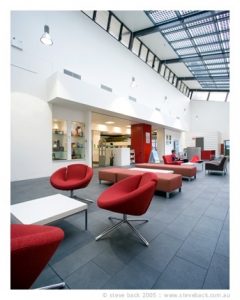
Kogarah Library & Cultural Centre |

Manly Library Ferry Service |
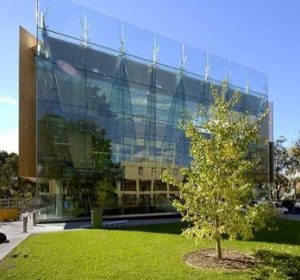
Surry Hills Library |
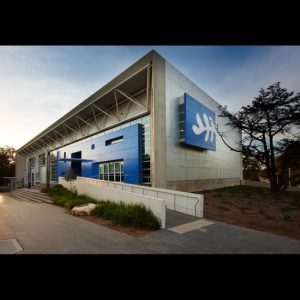
Concord Public Library |
Over the years I’ve observed the public library sector face many challenges including the constant of reducing resources, the march of technology and the development of the internet, the shift to digital resources and the ever demanding expectations of users. I’ve seen public libraries reeling from the pressure but they have emerged, survived and grown. Public library managers have worked together as stewards of their collections, as hosts of relevant programs and as managers of libraries as ‘people places’. They have stuck to their founding principles including the principles of access, equity, respect for learning and for local identity.
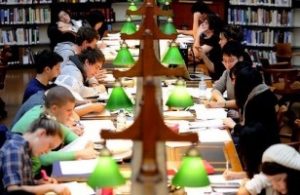
State Library of Victoria |
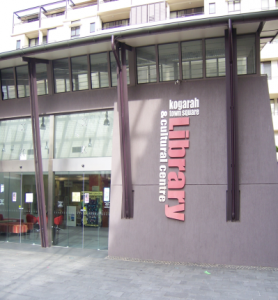
Kogarah Library and Cultural Centre |

Albury LibraryMuseum |
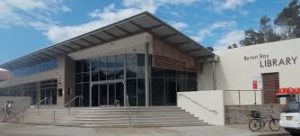
Byron Bay Library |
If I’ve learned anything from my observations it’s that generally effective public library managers and staff are in tune with their communities. They listen to the voices of their users, they actively network with their colleagues and are keen to experiment and try new ideas. They laugh at the stereotype of dusty silent library buildings, filled with never used books and operated by strict, rule-obsessed library police. Public libraries have evolved due to careful stewardship and the avoidance of unexpected radical makeovers. Public libraries in 2014 are confident and forward thinking – they know and value community trust and work hard to ensure that their partnership with the community is based on an equitable relationship of mutual respect.
The public library services that face scrutiny and challenge are often those that have lost sight of these fundamentals. For whatever reason when a public library becomes isolated, when it starts to behave as a superior expert with special knowledge and skills, when even library staff are not in the information loop and when changes to services and buildings are introduced without consultation, then management and governing bodies are heading for a rocky time of it. There are numerous examples of this but the most recent and still evolving example is the New York Public Library redevelopment 2012 and ongoing. It is fair to say that the current controversy about the makeover of the State Library of NSW’s Mitchell Reading Room is another case study example.
In both these scenarios and under challenge from the community, library management becomes testy and defensive and make claims that follow standard patterns such as ‘We’re undertaking change to improve services’ or ‘Change is normal and forward thinking. We know what we are doing. Trust us’ or ‘This is a small group with vested self-interest (read rat-bags). Ignore them and listen to us”. This is condescending and inappropriate and can generally indicate that management has lost touch with its community, actually doesn’t respect its users and pays lip service only to the principle of partnership. Often when the going gets heated, public relations consultants are called in to manage the message and to represent the library management case.
Boards of directors and trustees, usually with no knowledge of library practice, become the meat in the sandwich, running for cover whilst defending their management in the face of front page headlines and web based saturation cover. Just finding themselves in the spotlight should ring alarm bells at board level and alert them to the possibility that management is not as competent, engaged with customers or strategic as they thought.
The 21st century has seen remarkable changes in the management of cultural programs and facilities generally. New or upgraded buildings and programs demonstrate and encourage the principles of access and equity including in libraries but also in galleries, museums and centres for the performing arts. These principles have been joined by ‘participation’ and ‘engagement’ and woe betide any institution that does not embrace them.
Governments and users, visitors and audiences now expect to participate in the cultural life of their communities. Participation takes many forms including volunteering, consulting, responding, creating, collaborating, watching, observing, making etc. Participation encourages even greater and respectful partnerships between management and communities and provides another building block in the development of great and relevant public library services.
The management of change is a constant challenge for library management, as it is for communities. To achieve positive change and avoid change that destroys, library management must advocate for and demonstrate a commitment to active engagement with the library services’ diverse communities that will inform planning, build ownership, foster new ideas and encourage participation. This will result in sustainable and relevant facilities and programs into the future that preserve the best of existing services and spaces whilst adding in dynamic new ones.
September 2013
House names
I live in a house with a name – and I like it. Burrawong gives our home a unique identity and it makes a link to the house’s history. In my case it provides a connection to the natural environment; and the house sign also contributes to the house’s design aesthetic. The fact that our house has a name but not many others in the street do, got me thinking about house names – and their role in identity and sense of place. These are key issues for cultural planning and mapping, but to my knowledge house names haven’t featured in any cultural maps.
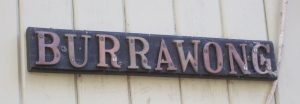
I do know that in Biarritz in France, house names are important and crucial identifiers – culturally and practically (location). I know this because during this year’s Sydney Film Festival I enjoyed an engrossing film by Oskar Alegria about his search for the location for Man Ray’s 1926 film, Emak Bakia. It turned out that Emak Bakia was the name of the house in Biarritz where the film was shot. Emak Bakia is a Basque expression meaning “leave me alone”. Who would name their home “leave me alone”? Therein lies a story, and one which leads the film maker on many detours as he searches for the origins of Man Ray’s film and then the house name.
But how are house names decided and why do some areas have lots of houses with names and others none? In Thredbo recently, I documented many house or lodge names (Schlupwinkel, Seidler Lodge etc). Is this a tradition for ski resorts? And in a small town in the Illawarra (Austinmer) I know that many of the house names relate to the area’s early colonial history (Westmacott, Cintra). A friend of mine has built a new house there – but no one has yet come up with a name for it. A name that captures the essence of the place, perhaps a name that reflects its past but also captures aspects of its current natural environment and also looks to the future.
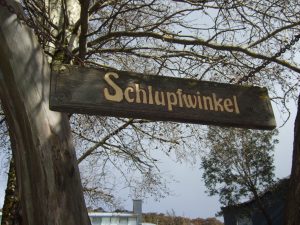 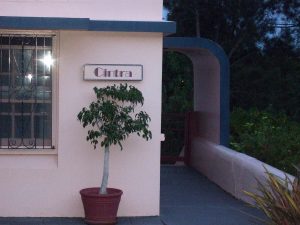 |
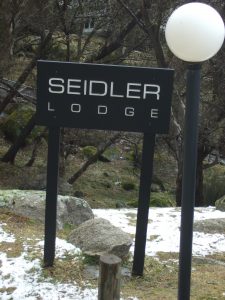 |
These are cultural questions – they reflect values, they often provide links to a particular theme (such as a link to nature, flora and fauna – Willow Grange, Pelican), to an event or unique personality in local history, to a favourite character or even a fond memory (e.g. a holiday place). Sometimes house names are linked to a particular family or a family pet, but there are no rules and they can reflect broad connections to a community and its way of life.
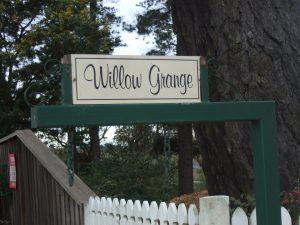 |
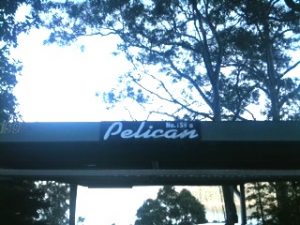 |
House names express difference, they are distinctive and often memorable providing a complement to street numbers. They can provide a connection and a basis for celebrating or capturing the history of a property – its relationships including early roots and history. They contribute sense of place and therefore are an element in cultural resource mapping and documentation.
June 2013
Joining the planning dots – the Bodalla story
Coolamon, Lightning Ridge, Aberdeen – all are small but dynamic towns in rural or remote New South Wales that are worth watching. And now after a visit to the South Coast in February 2013, I am keeping a watching brief on Bodalla too. For me, Bodalla has cultural vitality and the ingredients for a sustainable future – a distinctive identity, an accessible village main street with a growing range of destination choices, a recognised place in Australian colonial history, an emerging new and diverse economy, an interested community and a Shire Council generally prepared to give new ideas a go. It has access to a regional arts board that is making a difference across the south eastern region and importantly it also has local community leaders with vision and energy and a commitment to sticking around for the long haul.
Where, what and how
Bodalla is located between Moruya and Bega on the Princes Highway. It is well known for its dairy farming. We all remember Bodalla Cheese…. and until 1987 the Bodalla brand was widely available around the country. The Bodalla Estate was established in 1860 by Thomas Mort, a pioneer of Australian economic and industry development. From 1860 and until the 1930s the Bodalla Estate village with its farming surrounds was a thriving hub with a post office, store, church, hotel and school, telegraph office, hall, residences and cottages, bakery and smith. The village then went into a slow decline and in 1987 the Estate was broken up and the Big Cheese complex closed.
Despite its rundown state, the village has retained a distinctive cultural landscape reflecting its historic character. From its perch above the village, the imposing All Saints Anglican Church dominates the landscape. All Saints was commissioned by Mort, designed by colonial architect Edmund T. Blacket and opened in 1883. The Church is of high heritage significance with a tower, stained glass windows, mosaics and sits in a distinctive garden landscape.
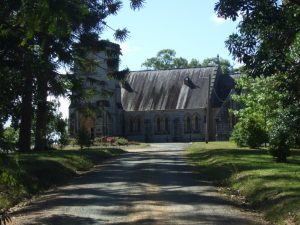 |
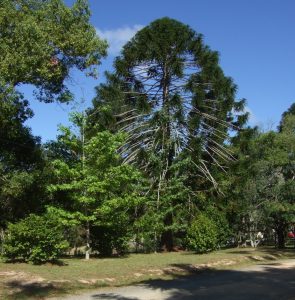 |
Recent initiatives
Now with an investment in robust research and analysis and some imaginative planning, Bodalla is reinventing itself. Local landowners and residents with vision are working with the local Eurobodalla Council and the community to reinvigorate the Bodalla economy. Sandra and Robert McCuaig with their daughter Jane Stuart have opened a Dairy Shed with retro milkbar and guesthouse in Bodalla. The new and co-located Cheese Factory provides an outlet for their range of Bodalla Dairy milk and cheese products. The McCuaig’s have also invested in the Bodalla Bakery and provide support and encouragement for the adjacent gallery which showcases local arts and crafts. You can even stay over in new B&B accommodation behind the Dairy Shed.
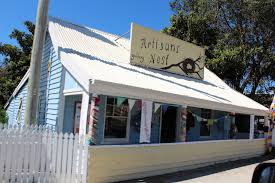 |
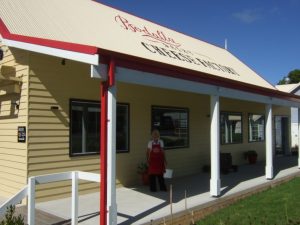 |
By taking an integrated approach to planning for Bodalla’s future, a sustainable direction is evolving. Bodalla’s heritage and history is appreciated and celebrated, opportunities for cultural tourism based on authentic experiences are being nurtured and new small business initiatives have been established which complement Bodalla’s emerging economy. Visitors and locals appreciate the areas’s clean and green natural environment and now have the chance to sample fresh, seasonal produce and products whilst talking to local growers and artisans. In recent years the region including Bodalla has attracted new people drawn by its mix of pristine environment, more relaxed lifestyle and support for creative pursuits. As older farming sectors decline new industries are emerging such as cultural tourism which embraces, events, markets and festivals and the desire for new and authentic experiences. This in turn generates new jobs whilst contributing to the quality of local life.
Collaboration and partnerships are a key to Bodalla’s future and Eurobodalla Shire Council has been active in ensuring that its planning tools complement the vision for the village. Strong community ownership for the opportunity to build a new model cultural ecosystem has set the scene for an ambitious experiment in 21st century rural planning. Bodalla we are watching.
May 21 2013
Stepping out and stepping up
Working as a cultural planner means that I am always on the lookout for how cities, towns and villages as well as individual people express their ways of life and their distinct identities. Every day brings new experiences and I enjoy watching, listening, observing and recording many interesting things from a cultural planners’ perspective. For example a commute on the bus, a weekend picnic in the bush, reading the local newspaper, visiting an artists studio or having dinner with family and friends – I take all these opportunities and many more to observe, absorb and evaluate since they all provide rich content and ideas that informs my work.
Until now I’ve not been able to share my experiences other than in conversation with friends, colleagues and clients or by digital sound and image recording. But now with a blog I can connect my observations and share some of the interesting sights and ideas I trip over on a daily basis. The blog provides opportunities to have a conversation about new trends, things I’ve seen, places I’ve been and ideas I’ve heard. It will contain comment, criticism and links to more information. I hope it will emerge into the light at least once a month.
So…. I’m stepping out – and one of the steps in launching this blog has been my recognition that I am actually fascinated by steps. Steps are important since they make getting from place to place easier (well for most people) and they also provide some logic in navigating long lists and complex challenges. They are really important to planning and can underpin process and procedures. I hope you enjoy the images on the Sue Boaden Cultural Planner web site especially the Step Series bringing you images of steps in their beauty and diversity as well as their history and utility.
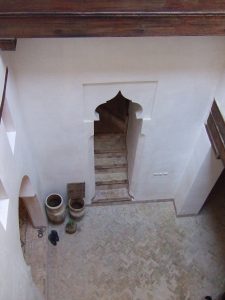
Private house (dar), Fez, Morocco |
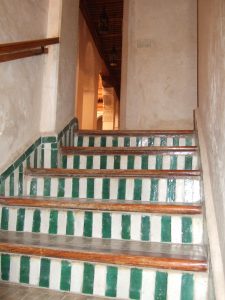
Fez Museum, Morocco |
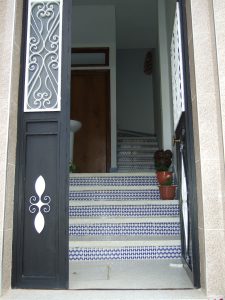
Tiled stairs, Moulay Idris, Morocco |
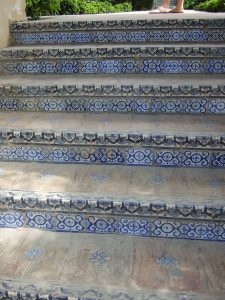
Tiled stairs, Reale Alcazar, Seville |
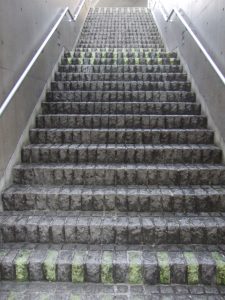
Garden of Fine Arts, Kyoto |
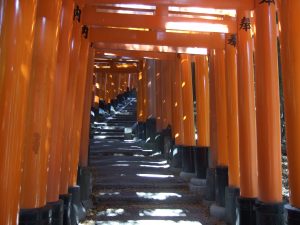
Fushimi Inari Temple, Kyoto |
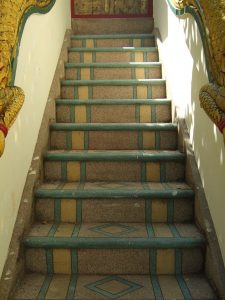
Temple, Chiang Mai |
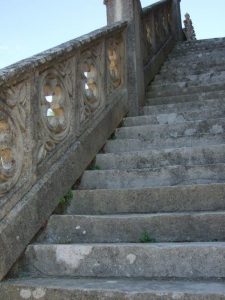
Najac hill town, France |
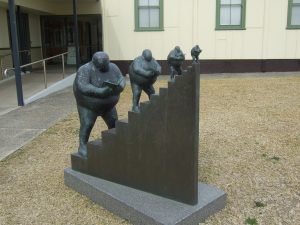
On the staircase by Keld Moseholm (Denmark) |
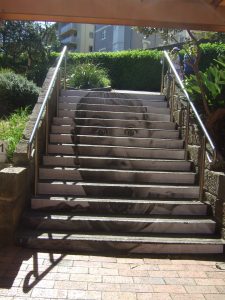
Mandy Schone-Salter, Step by Step, Manly Art Gallery exhibition |
